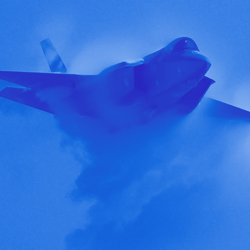Measurement, Modelling and Prediction of Hypersonic Turbulence
 This special issue has the goal of coordinating international research efforts among NATO members and partners on fundamental aspects of high-speed compressible turbulence, ranging from homogeneous isotropic conditions to wall-bounded flows, including thermochemical non-equilibrium effects, conjugate heat-transfer and high-temperature materials development.
This special issue has the goal of coordinating international research efforts among NATO members and partners on fundamental aspects of high-speed compressible turbulence, ranging from homogeneous isotropic conditions to wall-bounded flows, including thermochemical non-equilibrium effects, conjugate heat-transfer and high-temperature materials development.
Accurate aerodynamic predictions are critical for the design and optimization of hypersonic vehicles. Turbulence modeling remains a major source of uncertainty in the computational prediction of aerodynamic forces and heating for these systems. Currently, large discrepancies exist between predicted and measured turbulent aerodynamic heating, drag over high-speed configurations and mean turbulent flow features above complex geometries and/or non-equilibrium conditions, warranting the urgent development and improvement of multi-fidelity computational models.
High-quality experimental and computational databases for turbulence at Mach numbers above 5 are just starting to make their way into the literature. The present Special Issue aims at boosting the process by inviting contributions focusing on experimental and numerical studies in the field.
Topics covered include, but are not limited to:
- Detailed comparison of state-of-the-art numerical strategies such as DNS, LES, etc.. on the same canonical or complex flow setup
- Detailed comparison of state-of-the-art modeling strategies such as WMLES, DES etc.. the same canonical or complex flow setup
- Diagnostics for use in hypersonic turbulent boundary layers as well as high-speed high-enthalpy diagnostics
- Review of operational envelope of wind tunnel test facilities with test conditions relevant to hypersonic turbulence
- High-fidelity simulations and flow measurements of:
- reproduceable / canonical compressible turbulence cases such as: homogeneous isotropic turbulence, channel flow, spatially developing boundary layers, mixing layers, hollow cylinders, cones
- complex flow scenarios involving pressure gradient effects, double curvature effects (Bolt-II), or non-zero angles of attack
- Detailed comparison of state-of-the-art modeling strategies for turbulence/chemistry effects including LES of reactive flows, modeling of high-enthalpy flow effects, non-thermochemical-equilibrium and definition of canonical test cases relevant to hypersonic flight.
Guest Editors
Carlo Scalo, Department of Mechanical Engineering, Purdue University
Alexander Wagner, Institute of Aerodynamics and Flow Technology, German Aerospace Center
